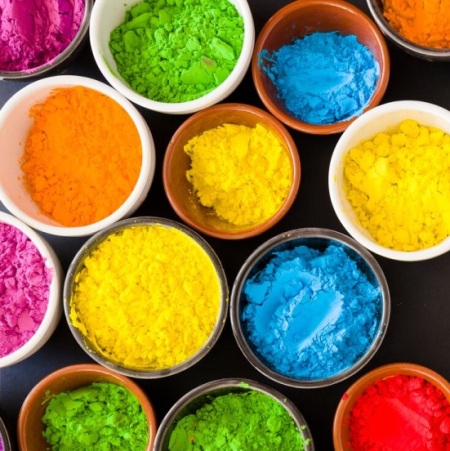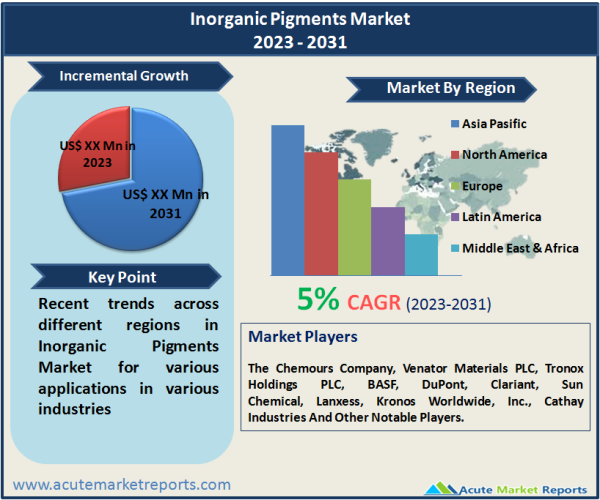
The inorganic pigments market is a vital segment of the chemicals and materials industry. The inorganic pigments market is expected to grow at a CAGR of 5% during the forecast period of 2025 to 2033, due to the increasing demand for paints and coatings, the rising packaging industry, and the development of the ceramic and glass sector. However, environmental regulations pose a significant challenge, prompting the industry to invest in sustainable alternatives. The market is expected to exhibit substantial growth, with titanium dioxide leading the way, particularly in the Asia Pacific region. Key players in the market are committed to delivering innovative and sustainable inorganic pigments to meet the evolving needs of various industries.

Increasing Demand for Paints and Coatings
Growth in the Construction Industry: One of the primary drivers of the inorganic pigments market is the escalating demand for paints and coatings. The construction industry witnessed substantial growth in 2024, driven by infrastructure development and residential construction projects. This, in turn, led to higher demand for inorganic pigments used as colorants in architectural paints and industrial coatings. The trend of robust construction activities is expected to persist during the forecast period from 2025 to 2033.
Automotive Industry Growth: The automotive industry's expansion also contributed to the increased use of inorganic pigments. In 2024, the automotive sector witnessed a surge in production and sales, and inorganic pigments found applications in automotive coatings and plastics. As the automotive industry continues to evolve, the demand for inorganic pigments is expected to rise during the forecast period.
Rising Packaging Industry
Packaging Material Requirements: The second key driver is the flourishing packaging industry. In 2024, the packaging industry experienced significant growth due to the increasing demand for packaged consumer goods. Packaging materials, including plastics and paper, utilize inorganic pigments for their printing inks and coloring. As consumer preferences for packaged products continue to rise, the packaging industry's expansion will fuel the demand for inorganic pigments throughout the forecast period.
Ceramic and Glass Industry Development
Architectural and Decorative Applications: The ceramic and glass industry played a pivotal role in driving the inorganic pigments market. In 2024, architectural and decorative applications of ceramics and glass witnessed increased utilization of inorganic pigments for coloring. The demand for aesthetically appealing tiles, glassware, and decorative ceramics surged. This trend is projected to continue into the forecast period as consumers and industries alike seek customized, visually attractive products.
Environmental Regulations and Sustainability Concerns
Stringent Regulatory Compliance: A significant restraint affecting the inorganic pigments market is the growing concern over environmental regulations and sustainability. In 2024, regulatory bodies imposed stringent guidelines on the use of inorganic pigments containing heavy metals, particularly in the paints and plastics industries. These regulations were enacted to reduce environmental harm and health risks associated with heavy metal pigments. Compliance with these regulations required investments in research and development for eco-friendly alternatives. This restraint is anticipated to persist during the forecast period, as environmental sustainability remains a critical issue.
Type (Titanium Dioxide, Iron Oxide, Carbon Black, Others): Titanium dioxide Dominates the Market
In 2024, titanium dioxide led the inorganic pigments market both in terms of the highest revenue and the highest compound annual growth rate (CAGR) during the forecast period from 2025 to 2033. Titanium dioxide is extensively used in the paints, coatings, plastics, and ink industries due to its exceptional whitening and coloring properties. While iron oxide and carbon black will maintain their significance, titanium dioxide is expected to retain its leadership in revenue and growth.
Application (Paints, Plastics, Inks, Ceramics, Glass, Others): Paints and Coatings Segment Dominate the Market
In 2024, they dominated the inorganic paints and coatings segment pigments market in both revenue and CAGR terms. This segment benefits from the increasing use of inorganic pigments in architectural paints, automotive coatings, and industrial coatings. During the forecast period, the ceramics and glass industry is expected to exhibit the highest CAGR due to the growing demand for aesthetically appealing and customized architectural and decorative products.
APAC Remains the Global Leader
In 2024, the Asia Pacific region led the inorganic pigments market in terms of both the highest revenue and the highest CAGR. This can be attributed to the region's burgeoning construction and automotive sectors, as well as the demand for packaging materials. North America and Europe, while significant in terms of revenue, experienced lower CAGRs due to market maturity. Asia Pacific is expected to maintain its revenue leadership and strong growth during the forecast period.
Investment in R&D to Enhance Market Presence of Market Players
The inorganic pigments market is highly competitive, with key players like The Chemours Company, Venator Materials PLC, Tronox Holdings PLC, BASF, DuPont, Clariant, Sun Chemical, Lanxess, Kronos Worldwide, Inc., and Cathay Industries leading in terms of innovation and market presence. These companies have consistently invested in research and development to enhance the quality and performance of their inorganic pigments, making them suitable for various applications. In 2024, these industry leaders secured substantial market shares and are expected to maintain their positions during the forecast period from 2025 to 2033. Their strategies include diversifying their product portfolios, developing eco-friendly pigments to meet environmental regulations, and expanding their geographic reach. Additionally, they actively engage in strategic partnerships and collaborations to ensure a steady supply chain and maintain a competitive edge.
Historical & Forecast Period
This study report represents analysis of each segment from 2023 to 2033 considering 2024 as the base year. Compounded Annual Growth Rate (CAGR) for each of the respective segments estimated for the forecast period of 2025 to 2033.
The current report comprises of quantitative market estimations for each micro market for every geographical region and qualitative market analysis such as micro and macro environment analysis, market trends, competitive intelligence, segment analysis, porters five force model, top winning strategies, top investment markets, emerging trends and technological analysis, case studies, strategic conclusions and recommendations and other key market insights.
Research Methodology
The complete research study was conducted in three phases, namely: secondary research, primary research, and expert panel review. key data point that enables the estimation of Inorganic Pigments market are as follows:
Market forecast was performed through proprietary software that analyzes various qualitative and quantitative factors. Growth rate and CAGR were estimated through intensive secondary and primary research. Data triangulation across various data points provides accuracy across various analyzed market segments in the report. Application of both top down and bottom-up approach for validation of market estimation assures logical, methodical and mathematical consistency of the quantitative data.
| ATTRIBUTE | DETAILS |
|---|---|
| Research Period | 2023-2033 |
| Base Year | 2024 |
| Forecast Period | 2025-2033 |
| Historical Year | 2023 |
| Unit | USD Million |
| Segmentation | |
Type
| |
Application
| |
End-Use
| |
|
Region Segment (2023-2033; US$ Million)
|
Key questions answered in this report